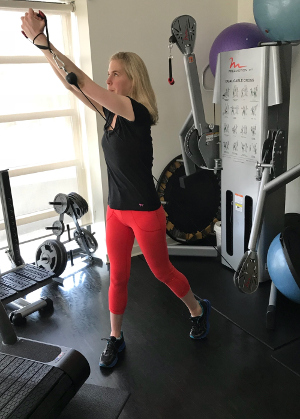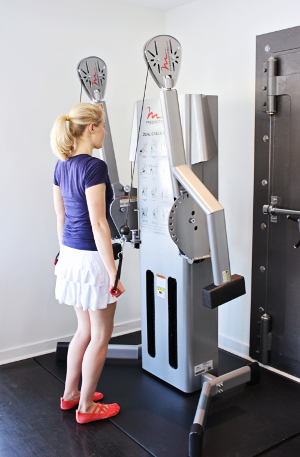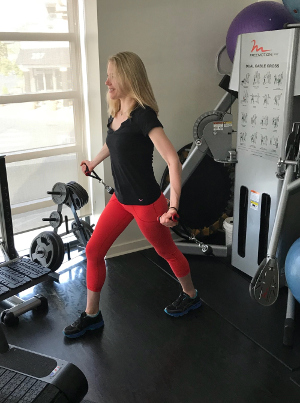THE VERSATILITY OF CABLE MACHINES

Recently I have been writing a series of “How to use X’ blogs, covering how to use everything from cardio machines such as the elliptical and the treadmill, to free weights, to small pieces such as the stability ball and foam roller. I even broke down how to properly warm-up and cool-down. By now you are all glorified exercise mavens — or at least on your way there!
What have we not talked about thus far? Larger pieces of workout equipment such as cable machines or full home gym equipment. Today we fill the void. This blog, cable machines. Next blog, home gyms.
Cables are a personal favourite. Why? They are versatile — they allow for traditional strength exercises such as triceps press-downs and biceps curls, and also dynamic full-body motions such as wood chops and single-limb motions (which require core stability) such as unilateral flys. I am biased towards the cable cross system I bought for my studio; I love that the arms of the cable machine don’t simply move up and down, but also forwards and backwards. Can you say fitness fun?
Two ways to use cables
Broadly speaking, there are two ways to use cables: either you mimic more traditional strength moves (such as flys) or perform more dynamic multi-joint — often sports-specific — moves (such as the wood chop).
Triceps press-downs: Stand facing the machine holding a press-down bar or rope. Move the cable “arm” to its high position so you are pulling down. Chest out. Core engaged. Keep your elbows into your sides.
To perform the move, straighten your arms. Then slowly control the weight back to your starting position. Don’t let your elbows leave your sides.
Biceps curls: Stand facing the machine holding a press-down bar or rope. Move the cable “arm” to its low position, so you are lifting weight up. Chest out. Core engaged. Elbows into your sides. Arms start straight. To perform the move, bend your elbows. Then slowly control the weight back to your starting position. Don’t let your elbows leave your sides.

Cable flys: Face away from the machine. Hold one D handle in each hand with both arms of the machine at chest height. Start with your arms almost straight — have a slight bend in your elbows. Move from the shoulders so your arms move in front of you — as if you were hugging a tree. Keep the angle of your elbows stable. Slowly control your arms back to their starting position.
More dynamic functional Moves
Wood chop: Start holding a D handle with the cable machine arm at its lowest position. Stand perpendicular to the machine with your right leg closest to the machine. Squat down with your arms straight and hands to the outside of the right leg. As you exhale rotate your body left — arms straight. Use your pelvis and core to initiate the rotation. Control back down.
For variety, try a high wood chop: The motion is the same, but the arm of machine is anchored high. Thus, your arms start high. Squat as you “chop” your arms down towards the floor (arms end to the outside of the outside ankle).
Dynamic chest flys: Make the traditional chest fly dynamic by doing a “high fly” (machine arms start above your shoulders), a “low fly” (machine arms start below hip height), or a “single-arm fly” (arm at any level — stabilize with your core so your pelvis stays stable), or by adding a lunge to the motion.
A few things to keep in mind
-When training with cables you can manipulate variables including reps, sets, weight, rest, arm height, tempo (speed), attachment types (rope, D handle, straight bar, etc), and whether you do bilateral or unilateral variations. How you manipulate these variables will depend on your goals and fitness level.
-If you’re a newbie lifter, aim for 1-2 sets
 of your chosen exercise. A set is the completion of a pre-determined number of repetitions. A repetition is one time through a motion. So, if you are doing 2 sets of twelve reps, you would complete 12 full repetitions without resting. After resting you would complete a second set of 12 repetitions.
of your chosen exercise. A set is the completion of a pre-determined number of repetitions. A repetition is one time through a motion. So, if you are doing 2 sets of twelve reps, you would complete 12 full repetitions without resting. After resting you would complete a second set of 12 repetitions.
-If your goal is muscular endurance, aim for 12-15 reps. For muscular strength and hypertrophy (growth) aim for 8-12 reps with more weight. For muscular power and strength aim for fewer reps (5-8) with a higher weight.
-Typically, the higher your weight and the lower your repetitions, the longer your rest period.
-In general, faster movements develop power, speed, and fast-twitch muscle fibres. A slower tempo develops control and strength and is an excellent way to get you acquainted with a movement pattern. Don’t confuse people who move quickly because they never learned correct lifting techniques with experienced lifters who are taking their workouts to the next level. Cable newbies should start by using a manageable weight and a slower, more controlled tempo. Only progress to performing explosive exercises when you can execute the motion with perfect form.
Originally published at FLAMANFITNESS












